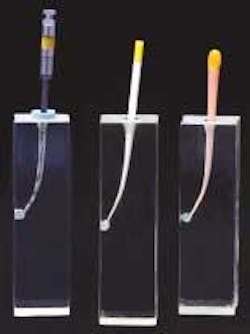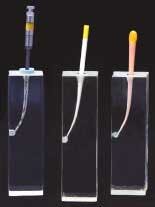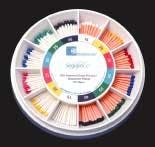Real World Endodontics
Products and techniques that will make your endodontic experiences better!
By Kenneth Koch, DMD, and Dennis Brave, DDS
How important can the humble paper point be? Well, it can actually be a significant contributor to painless endodontics. But the importance of the quality of the paper point, along with the quality of the gutta percha cones themselves, are often overlooked in endodontics. Real World Endo has addressed the current limitations in both paper points and gutta percha cones through the introduction of our Sequence cones. To further understand their importance, let's begin by examining the simple paper point.
Too often we see dentists using XF or XXF paper points for drying all their canals. Routinely, it takes four or five points to "seemingly" dry the canal. Why does it take so many and what does it really mean?
First, it means your paper point does not match your preparation. If you finish your rotary preparation to a size 25/.06 taper, you should be using a 25/.06 paper point, not a XXF. Does it really matter? Yes! By not using the correct size paper point, you are not desiccating the canal as thoroughly as possible. This is a big problem because any remaining sodium hypochlorite (bleach) can easily be extruded out past the end of the tooth during the obturation process, particularly when using a thermoplastic technique that employs a solid core carrier. However, quite often, any insertion of gutta percha can drive this residual bleach out past the end of the tooth, resulting in postoperative sensitivity. Consequently, one of the paradigms in painless endodontics is to employ a paper point that truly matches the preparation. The EndoSequence paper points not only match the preparations, they actually exhibit tug back!
After using a properly sized paper point, you will quickly realize that when you have a paper point that truly matches your preparation, it becomes much more than a piece of paper. It becomes a tool. The correct paper point can be used effectively to deliver sealer into the canal, blot out excess sealer, and even place calcium hydroxide into the canal system as a medicament.
Having addressed the importance of the paper point, the next question should be, "Are you getting the most from your gutta percha?"
Again, it sounds like a simple question, doesn't it? But there is a lot more to placing gutta percha into a canal than you may realize. Let's take a closer look at gutta percha cones and how to insert them properly.
The first aspect that we need to examine is the gutta percha cone itself. Gutta percha cones vary significantly from one manufacturer to the next. They not only differ in proprietary composition, but also in true size. This variation can be a serious concern when performing single cone techniques or when fitting main cones to a machine-tapered preparation. Real World Endo has identified the current limitations in gutta percha cones and attempted to address them through the introduction of our new Sequence cones.
The first limitation we noted was the historical lack of stiffness in gutta percha cones. Too often, we have encountered gutta percha that either collapsed at the end (especially in small sizes) or doubled back on itself. In the past, we actually sprayed some gutta percha cones with Endo Ice™ to make them stiffer. This further evolved into our treating gutta percha cryogenically in an attempt to make it stiffer and more adhesive.
However, these treatments did not fully meet our requirements and, as a result, we went directly to a gutta percha manufacturer. We asked the manufacturer to give us a cone that would be stiffer by slightly changing the molecular weight of the gutta percha. In fact, we were given, through a proprietary process, a stiffer cone by altering the molecular phase. Consequently, as a result of these efforts, you will find the Sequence cones stiffer and easier to pre-curve than current gutta percha cones.
The true benefit of a stiffer cone is realized when you insert the cone into a canal. This is particularly noticeable in curved canals with sizes 25 and 30.
Having solved the initial problem of the material itself, our next challenge was to get cones that would precisely fit tapered, machined preparations. This was important because endodontic therapy should be precision-based.
As previously mentioned, historically there has been significant variation among manufacturers in ISO sized, tapered cones. This is a major problem when doing single cone or modified single cone techniques. We have seen this problem particularly on long teeth, such as maxillary canines.
If the cone is not precise, it will hang up in the coronal part of the canal and the clinician will be short by 1-2 millimeters. However, the problem of variable cones has been solved because the Sequence cones are verified by laser to confirm their size and taper.
Furthermore, in addition to the laser-verification process, our cones are hand-rolled, not machined. Amazingly enough, hand-rolled gutta percha cones are more accurate than purely machine-made. The net result of hand-rolling and laser verification is that the Sequence cones are exceedingly accurate in both size and fit.
The next issue we must address is the amount of sealer (cement) used during the obturation process. As a result of having learned the lateral condensation process (where we have a series of cones in a sea of cement), many clinicians have had the tendency to use too much sealer. The result can be an extrusion of sealer that may result in postoperative sensitivity. Please use only a thin amount of sealer. We recommend that you lightly coat the walls of the canal with sealer that is delivered on a hand file or a paper point. If you think that you may still have too much sealer, simply blot out the excess sealer with the appropriate size paper point. We also want you to lightly coat the main cone, prior to insertion. Now, we're ready for placement of the main cone.
However, don't insert the main cone quickly. If you insert a precision fit gutta percha cone in a rapid manner, it will act like a piston and extrude the excess sealer. Instead, introduce the cone into the canal in a slow controlled manner. A further modification is to take the cone down into the canal slowly and in a circular motion. This technique (Nasseh technique, developed by endodontist Dr. Ali Nasseh of Boston, Mass.) will help ensure that any excess cement will flow back up and out of the canal, rather than be extruded past the apex of the tooth.
A final modification we have made to the gutta percha cones and paper points is the delivery system. The EndoSeqence gutta percha and paper points come in an easy-to-use, refillable non-spill dispenser. It is shaped like a wheel and contains both gutta percha and paper points in ISO sizes 15-40. Additionally, it is available in tapers .04 and .06. Refills are available for all the individual sizes and also include sizes 45 and 50.
So, there you have it. The humble paper point and the basic gutta percha cone.
Dr. Dennis Brave is a diplomate of the American Board of Endodontics and a member of the College of Diplomates. In endodontic practice for 27 years, he was the senior managing partner of a group specialty practice. Formerly an associate clinical professor at the University of Pennsylvania, Dr. Brave currently holds a staff position at The
Dr. Kenneth Koch is the founder and past director of the program in postdoctoral endodontics at the Harvard School of Dental Medicine. In addition to having maintained a private practice limited to endodontics, he has written numerous articles on endodontics and maintains a faculty position at Harvard.
They can be reached at Real World Endo at (866) 793-3636 or through www.realworldendo.com.


